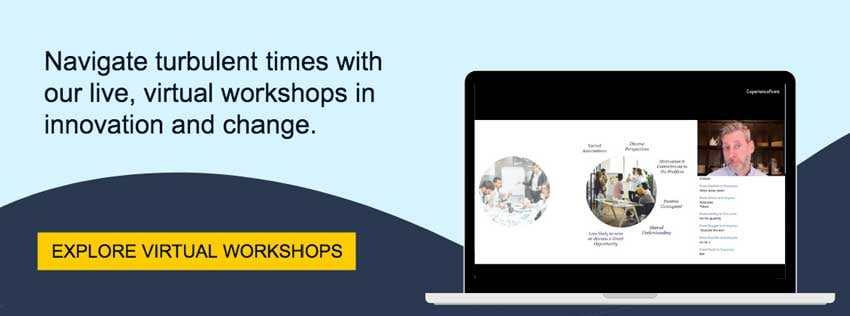Today’s job market is more competitive than ever before. The monumental events of 2020 have led to massive fluctuations in industries and a re-shifting of jobs roles, all resulting in a new rush to find and secure stable and meaningful employment.
In our recent blog posts, we’ve covered why possessing human-centered skills will continue to be an enormous competitive advantage for those seeking work in our modern world.
But why not consider how the human-centered design method, both in its principles and application, could benefit the job-seeker throughout the application process?
Brainstorming your Ideal Position:
When it comes to looking for work, there are plenty of ways you could put the human-centered design method… to work… right away. Firstly, as human-centered design is solutions-based method grounded in research, let’s allow that same energy to kick off the job-hunt.
Before you begin to scour the internet for job openings, ask yourself: If there were no barriers at all, what would be my absolute dream job? As human-centered design would emphasize, do not restrict yourself in these beginning stages of brainstorming. Open your mind to the most out-there ideas first and then work to reign them in from there.
Let’s say, for example, that your answer was: A surf instructor in Bali. Likely this job has no particular relevance to your existing resume, but look a little further and the answer will likely give way to some very relevant insights: Perhaps the answer means that travel and exploration is very important to you — so maybe a remote position that allows freedom of movement would be something to consider? Or a company with connections to health, wellness and physical activity. Write it all down!
Further, don’t forget that human-centered design focuses on collaboration. As you begin to narrow down your next career move, invite your family or friends to participate in a brainstorm. Ask them what type of role they would see you excelling in? What are your strong points? What areas of work might you consider that you haven’t thought of yet?
All this sad, it is important to recognize that employment is often an urgent necessity and there may not be space to explore openings that don’t match your precise qualifications. However, completing human-centered exercises like these can highly effective in kickstarting your job hunt and honing in what’s important to you as you embark on a new professional endeavor.
The Application Process:
There are plenty of ways that a person might leverage human-centered design principles as they pursue their next career move. Using them to guide the creation of one’s cover letter and resume are just one.
In most cases, these application assets are presented in paper or digital format. Being that as it may, and considering that recruiters are often on the lookout for employees with more than technical skill, it is important that we consider how to represent our human side in these documents.
Of these two major application forms, the cover letters allows for more freedom in the expression of the person’s character, desires and values. In a nod to human-centricity, ensure that you embrace this important opportunity to be bold and creative and to express why this position would be the perfect fit for you.
Ditch the templates that have kept you in a particular box and jot dot as many wild thoughts as you’d like before tailoring down the delivery to its most fundamental points. Collaborate with your friends and family and get their feedback on what you’ve written, be open to their feedback and don’t be afraid to adjust your ‘cover letter prototype’ a few times before firing it off.
Finally, be mindful of incorporating the mention of soft skills in your resume. Providing work examples that show such characteristics as Adaptability, Courage and Open-Mindedness, all of which make up the core attributes of a successful human-centered designer, will go a long way to making your application stand out.
The Interview
The interview is arguably the most important step in the job-seeking process. Here is your ultimate opportunity to lead with a human-centered foot and prove to the employers that your skills reach well beyond those listed on your resume.
First, step into the interview with a human-centered mindset. Remember that everyone present is a potential colleague, but also a person. Being human-centered in this instance might mean asking the recruiters how their day has been so far, making sure to remember and repeat their names during your conversation and repeating back some of the things they’ve mentioned to show you’ve been actively listening are collaboration-minded.
Further, amongst the many stories of triumph and success you’re likely to tell, consider telling one story of a time you took a risk and failed. Explain what this situation taught you and how you applied those lessons going forward. Showing that you possess both the courage to try new things and the ability to take ownership for them and adapt your behaviour will go a long way towards convincing recruiters that they’d be lucky to have you on the team.
Finally, use this opportunity to showcase your inherent creativity. In respectful tones, mention an issue you know the company has been having, or something you’ve noted could be improved on, and proceed to present innovative solutions for them. Use a basic human-centered design process to arrive at these solutions in advance, and impress your potential employers with these bold, thought-provoking and human-centered ideas.
